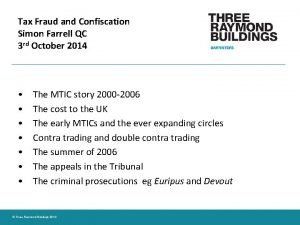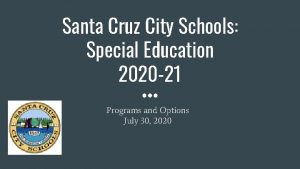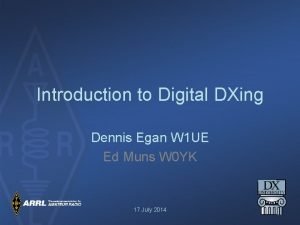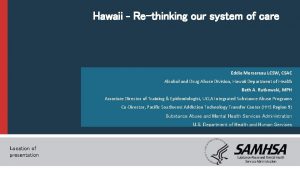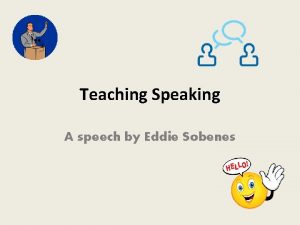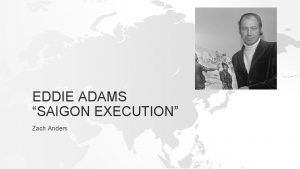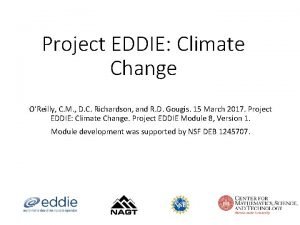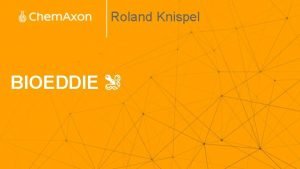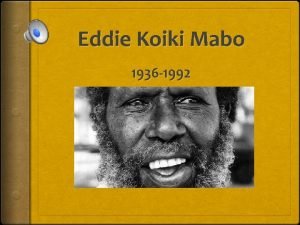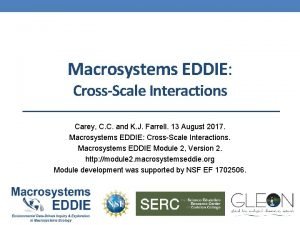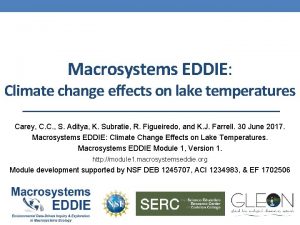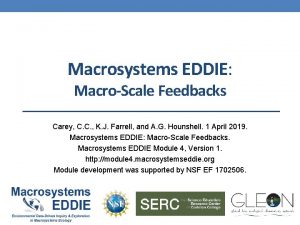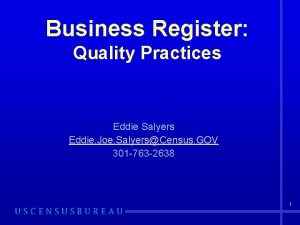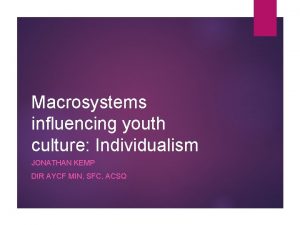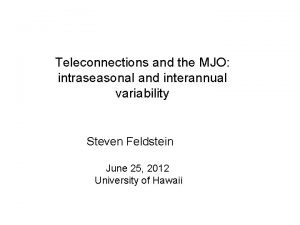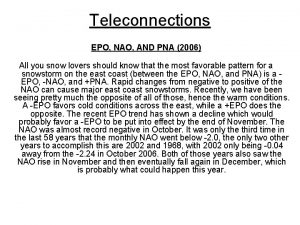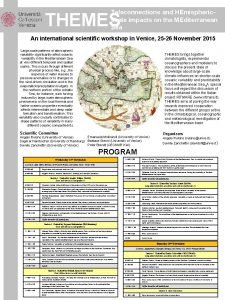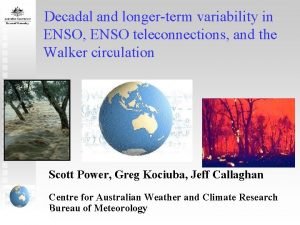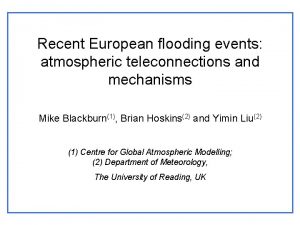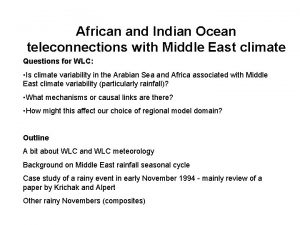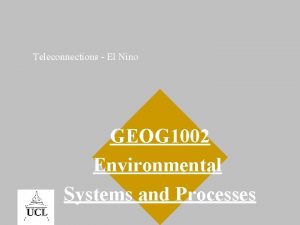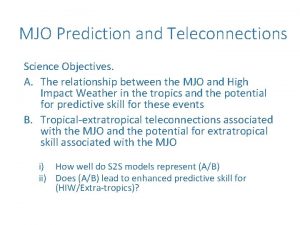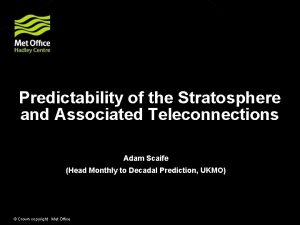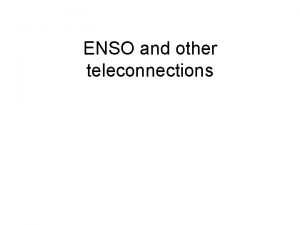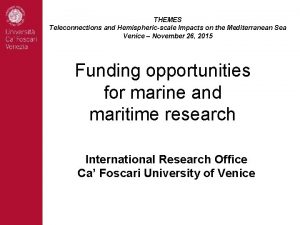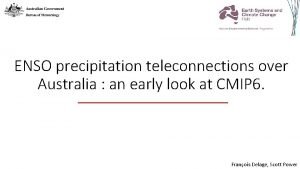Macrosystems EDDIE Teleconnections Farrell K J and C




























- Slides: 28

Macrosystems EDDIE: Teleconnections Farrell, K. J. and C. C. Carey. 18 May 2018. Macrosystems EDDIE: Teleconnections. Macrosystems EDDIE Module 3, Version 1. http: //module 3. macrosystemseddie. org Module development was supported by NSF EF 1702506.

Plan for today: § Short overview on teleconnections and their effects on lakes, and how we can use a macrosystems ecology and lake modeling approach to understand this phenomenon! § Activity A: Run and explore a whole- lake simulation model in R § Activity B: Use long-term data to simulate two different El Niño climate scenarios, generate hypotheses, and model how different lakes respond § Activity C: Discuss how the strength of global El Niño teleconnections varies among different lakes locally and regionally in altering lake temperature and ice cover Image: NOAA

What are teleconnections? § Teleconnection: a phenomenon that links remote regions via cause and effect relationships § Ecosystems can be influenced by climatic, societal, economic, and/or ecological changes in distant regions through teleconnections § Agricultural fields in the midwestern United States provide food for overwintering snow geese § Additional food has lead to rapid population growth, with negative effects for arctic marshes where the geese spend the summer Image: birdsna. org Image: Wikimedia Commons

El Niño/Southern Oscillation (ENSO) Teleconnection § A climate phenomenon in the tropical Pacific Ocean where ocean surface temperatures are warmer than average § Warmer ocean temperatures affect atmospheric circulation, air temperatures, and precipitation worldwide but in different ways based on your region!

Global land surface temperatures typically warmer in El Niño years: but what about lakes? Figure: Dana Nuccitelli via www. theguardian. com

0 How does lake temperature vary seasonally? Ice cover 20 Depth (m) 4 15 10 6 Thermocline 8 5 Changing lake level Jan. 2013 Hypolimnion Apr. 2013 Jul. 2013 0 Oct. 2013 Lake Sunapee, NH, USA: data from Lake Sunapee Protective Association buoy Temperature (°C) 2 Epilimnion

What are the drivers of water temperature? § Solar radiation § Air temperature § Wind § Precipitation § Inflow & outflow streams § All of these factors will interact to control water temperature, ice cover, and more! Figure: Hipsey et al. 2014

Using a macrosystems ecology approach to study the effect of ENSO on lakes § Drivers of water temperature occur at local, regional, and continental scales § Local = e. g. , inflow streams § Regional = e. g. , weather patterns § Global = e. g. , El Niño forcing § Macrosystems ecologists study ecological dynamics and feedbacks at multiple interacting spatial and temporal scales § We can study local, regional, and global drivers using high frequency sensor data + simulation models Figure modified from: Heffernan et al. 2014

El Niño effects on air temperatures vary regionally; can we detect this pattern in lakes? § In the U. S. , the greatest increases in warm weather are on the west coast and in the midwest § On the east coast and in the south, temperatures do not increase as much during El Niño years

Teleconnections in lakes § Lake temperatures and ice cover duration are likely affected by ENSO events, but little is known about lake responses § The effect of El Niño on a lake may depend on the strength of the El Niño forcing itself, the region in which a lake is located, and local lake characteristics C. C. Carey § Today, we’re going to examine how the effects of El Niño teleconnections on lakes across the U. S. are mediated by local and regional factors C. C. Carey

Why studying ENSO effects on lakes matters: § Even warming of just 1 o. C due to ENSO can have substantial effects on lake thermal stratification, oxygen concentrations, nutrient cycling, algal blooms, and fish habitat Image: Wikimedia commons § These changes can propagate over time: e. g. , as lakes lose ice in warmer winters, they absorb more heat, resulting in warmer summer water temperatures Image: Wikimedia commons

Our focal question: How do global ENSO teleconnections interact with local and regional characteristics to affect lake temperatures and ice cover? Image: Wikimedia Commons

Models to identify drivers across scales § How can we test the effects of remote drivers on lake temperatures and ice cover? § Impossible to experimentally manipulate climate drivers in lakes across a continent! § Simulation modeling allows us to explore how different lakes respond to a change in one or more drivers: § For example, how would lake temperatures and ice cover change across the continent in response to an El Niño year? -2°C +2°C

GLM: General Lake Model § The General Lake Model (GLM) is an open-access model for simulating lake dynamics § GLM simulates vertical stratification and mixing and accounts for the effect of inflows/outflows, surface heating and cooling § GLM has been designed to be an open-source community model developed in collaboration with members of the Global Lake Ecological Observatory Network (GLEON) to integrate with lake sensor data § Authors: Matt Hipsey, Louise Bruce, and David Hamilton http: //aed. see. uwa. edu. au/research/models/GLM/

Figure: Hipsey et al. 2014

Basic structure of the model § You have downloaded all the necessary files to run GLM in the Macrosystems EDDIE "teleconnections" folder § Within this folder, you will have: 1) 2) 3) A meteorological CSV (‘met’) file that forces the model (met_hourly. csv) An ‘nml’ text file that acts as ‘master’ scripts for the model (glm 2. nml) Inflow/outflow CSV files that specify the temperature and flow rate of connected streams entering and leaving the lake (if you lake has surface inflows and outflows!) Images: Wikimedia commons

Example met file

Example. nml file

Example inflow file (for lakes with inflows)

We will run GLM using R § R is a statistical environment that can run on different computer operating systems (PC, Mac, Linux) § R is reproducible, free(!), and easy to download § R can run stats, make figures, and do a suite of different analyses in many disciplines § Many packages for R to merge with other tools (including GLM!) § We’ll walk you through each step of the script, so don’t worry if you’re new to R!

Lakes we’re going to model today, using a suite of available continental datasets GLEON. org engr. wisc. edu

Learning objectives § Understand the concepts of macrosystems ecology and teleconnections, and how different ecological processes can interact at local, regional, and global scales § Set up and run ecosystem models to simulate lake temperatures and ice cover in multiple lakes (Activity A) § Test the effects of teleconnected climate scenarios on the different lake models, and examine how local characteristics modify global-scale climate forcing effects on lake temperatures and ice cover (Activity B) § Compare the role of teleconnections in driving lake temperatures and ice cover across multiple lakes in different regions (Activity C) § Predict how lake temperatures and ice cover may respond to changes in the timing and intensity of global-scale meteorological phenomena (Activity C)

Discussion questions embedded in your handout § Everyone will turn in the completed handout with question answers written out at the end of the module today. § We encourage you to work with your partner to complete the questions! Image: newsfrom 4 j. wikispaces. com

A few important notes about R • Lines of code that start with # are not read by R • These lines include important notes about how and why the R script is running, so be sure you’re reading them! • Lines with ##!! indicate lines of code where you need to modify something for it to run • In the glm 2. nml file, ! indicates lines that are not read by the GLM model (tricky!) • When you need to modify your glm 2. nml file in Activity B, make sure you’re not changing the value in a line that starts with a ! or your changes won’t be read by GLM

Activity A: Run a lake model! With a partner (work in pairs): 1. Download the zipped folder of R scripts and other files to run this module from http: //module 3. macrosystemseddie. org. Unzip the folder to your Desktop 2. Install the GLM files and R packages onto your computer 3. Choose a lake! Look up your lake’s characteristics in the file provided 4. Run the GLM model for your lake and explore the output for lake temperature and ice cover under the baseline (non-El Niño) scenario

Activity B: El Niño scenarios 1. Using the long-term climate data provided for your lake, calculate how air temperatures for your model lake would change in a "typical" and a "strong" El Niño year compared to baseline (non-El Niño) conditions. Record your lake's "typical" and "strong" offsets (°C) on the board!! 2. Develop hypotheses about how changing air temperatures in the "typical" and "strong" offset scenarios affect lake temperatures and ice cover relative to baseline 3. Use R to create meteorological input files that reflect your lake’s El Niño offsets, and run the two El Niño scenarios ("typical" and "strong") for one year § Analyze the model output to determine how lake temperature and ice cover varied among the three scenarios (baseline, "typical" and "strong") 4. Create a few figures that examine your El Niño scenarios: § Does the model output support or contradict your hypotheses? § How does the model output differ between the baseline scenario, the "typical" El Niño, and the "strong" El Niño?

Activity C: Compare lake responses to El Niño With your partner, compare your model outputs for the different scenarios to the NOAA map predictions, and explore lake characteristics that help interpret your lake's response to different El Niño scenarios 2. As a class, explore how the temperature offsets and lake responses differed among the lakes modeled by the class: § How do the temperature offsets for "typical" and "strong" El Niño scenarios differ among the model lakes based on their region? § Does the class’ model output support or contradict your hypotheses about which lakes would respond most strongly to El Niño scenarios? 3. Discuss: § What do the model outputs across multiple lakes tell us about how regional context mediates global teleconnections? § How might El Niño teleconnections affect lakes in regions we didn't model? 1.

Thank you for participating!
 Simon farrell qc
Simon farrell qc Stacy o'farrell santa cruz
Stacy o'farrell santa cruz Christ be our light shine in our hearts
Christ be our light shine in our hearts Byron farrell
Byron farrell Farrell bag troubleshooting
Farrell bag troubleshooting Detroit matchmaker
Detroit matchmaker Who is farrell jarreau
Who is farrell jarreau Eddie and henry language paper 2
Eddie and henry language paper 2 Each easter eddie eats eighty easter eggs
Each easter eddie eats eighty easter eggs Dxing decoder
Dxing decoder Eddie mersereau
Eddie mersereau Phrases vs sentences
Phrases vs sentences L'oiseau bleu eddie constantine
L'oiseau bleu eddie constantine Eddy offord
Eddy offord Eddie constantine chante avec sa fille
Eddie constantine chante avec sa fille Eddie saigon
Eddie saigon Eddie adams
Eddie adams How global warming works
How global warming works Eddie rosen brian rosen
Eddie rosen brian rosen Eddie js
Eddie js Eddie adams arc flash
Eddie adams arc flash Bonita neehow
Bonita neehow Eddie tsai
Eddie tsai The accounting issue(s) in the crazy eddie case were:
The accounting issue(s) in the crazy eddie case were: Purple pink brown
Purple pink brown And because i am happy and dance and sing
And because i am happy and dance and sing Romeo and juliet vs west side story venn diagram
Romeo and juliet vs west side story venn diagram Taller stronger little sister
Taller stronger little sister 75 centavos in symbol
75 centavos in symbol
